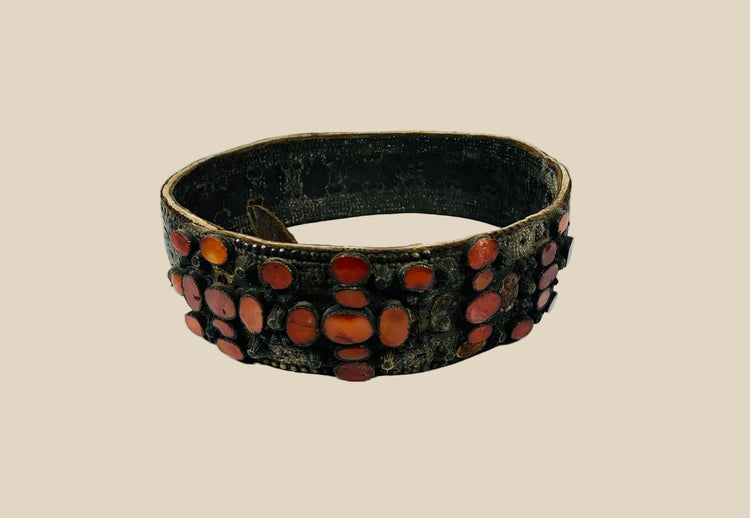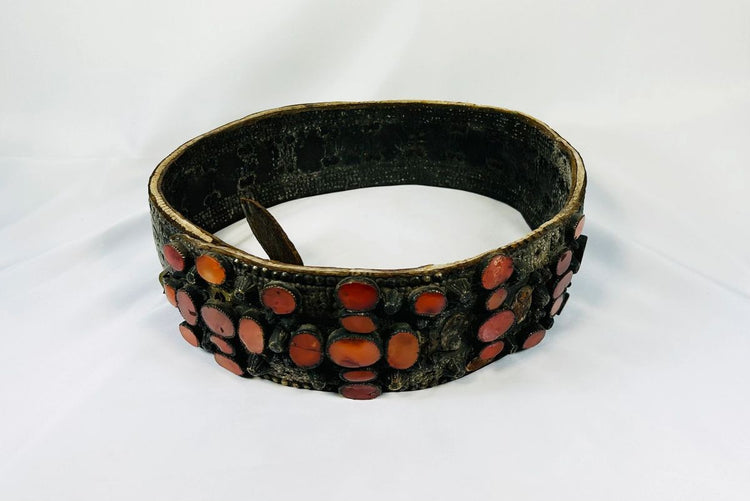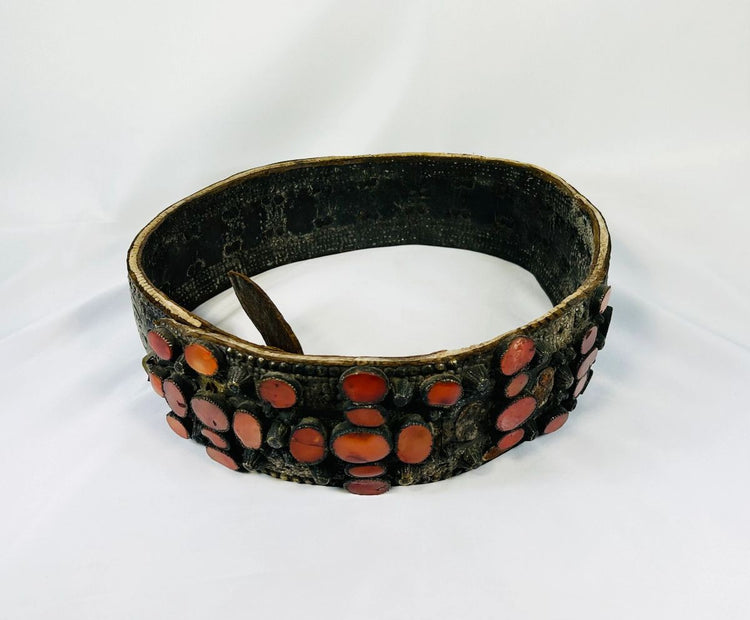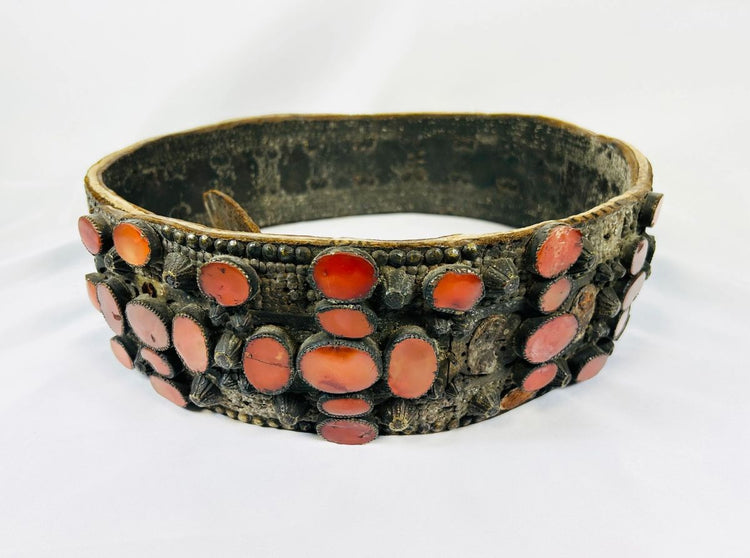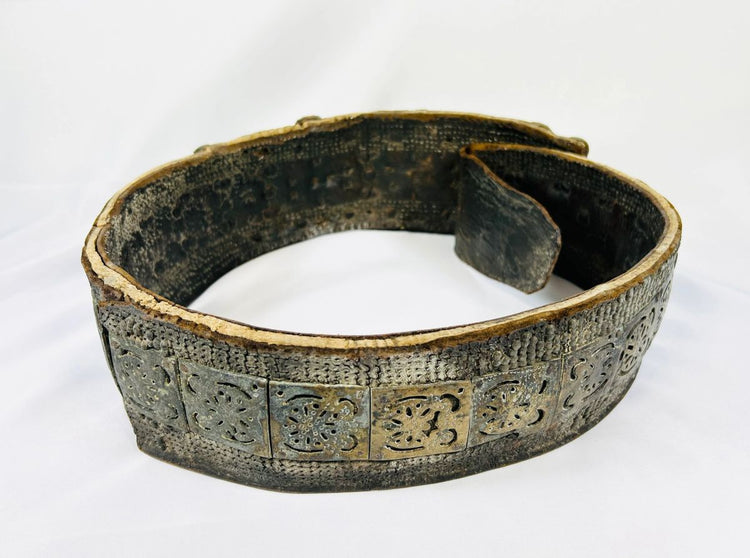Southern Russian Jewish Bridal Belt | Brass and Cornelian Stones | 17th–18th Century
Description
More
Less
Historical Context & Origin
Region: Southern Russia, Eastern Europe
Material: Brass with pierced plates, Cornelian stones, riveted fittings
Period: 17th–18th century
Description
This ornate bridal belt, studded with vibrant orange Cornelian gemstones, represents a rare survival of Jewish wedding customs from Southern Russia in the 17th–18th centuries. Weighing heavily and crafted with brass fittings and pierced plates, the belt is not only a striking ornament but also a sacred ceremonial object imbued with spiritual meaning. The fine workmanship and use of semi-precious stones reflect its role as both a protective talisman and a display of family status.
Features
- Rows of orange Cornelian stones, associated with vitality, protection, and fertility
- Heavy brass construction with riveted and pierced plates, showcasing skilled craftsmanship
- Ceremonial wedding use, traditionally tied with the groom’s belt to symbolize unity
- Preserved with visible wear consistent with its age, underscoring authenticity
Cultural Significance
Within Jewish communities of Southern Russia and Eastern Europe, bridal belts carried deep symbolic meaning. They were tied together with the groom’s belt during the marriage ceremony, representing the sacred union of husband and wife. Believed to enhance fertility and ensure prosperity, these belts were cherished family heirlooms, sometimes borrowed when too costly to own.
The use of Cornelian, with its rich orange tones, reflects long-standing associations with healing, vitality, and protection, making this piece a powerful spiritual and cultural artifact.
Condition
Good condition with expected wear and patina; gemstones intact and brass plates showing aged character consistent with a ceremonial object of this age.
Dimensions (approximate)
Diameter: 11 in
Age
17th–18th century
Learn More
View a Similar Piece in the Sir Henry Wellcome's Museum Collection
Read More About What This Belt Was Used For: Southern Russia Bridal Belt
Description
Historical Context & Origin
Region: Southern Russia, Eastern Europe
Material: Brass with pierced plates, Cornelian stones, riveted fittings
Period: 17th–18th century
Description
This ornate bridal belt, studded with vibrant orange Cornelian gemstones, represents a rare survival of Jewish wedding customs from Southern Russia in the 17th–18th centuries. Weighing heavily and crafted with brass fittings and pierced plates, the belt is not only a striking ornament but also a sacred ceremonial object imbued with spiritual meaning. The fine workmanship and use of semi-precious stones reflect its role as both a protective talisman and a display of family status.
Features
- Rows of orange Cornelian stones, associated with vitality, protection, and fertility
- Heavy brass construction with riveted and pierced plates, showcasing skilled craftsmanship
- Ceremonial wedding use, traditionally tied with the groom’s belt to symbolize unity
- Preserved with visible wear consistent with its age, underscoring authenticity
Cultural Significance
Within Jewish communities of Southern Russia and Eastern Europe, bridal belts carried deep symbolic meaning. They were tied together with the groom’s belt during the marriage ceremony, representing the sacred union of husband and wife. Believed to enhance fertility and ensure prosperity, these belts were cherished family heirlooms, sometimes borrowed when too costly to own.
The use of Cornelian, with its rich orange tones, reflects long-standing associations with healing, vitality, and protection, making this piece a powerful spiritual and cultural artifact.
Condition
Good condition with expected wear and patina; gemstones intact and brass plates showing aged character consistent with a ceremonial object of this age.
Dimensions (approximate)
Diameter: 11 in
Age
17th–18th century
Learn More
View a Similar Piece in the Sir Henry Wellcome's Museum Collection
Read More About What This Belt Was Used For: Southern Russia Bridal Belt
You May Also Like


















